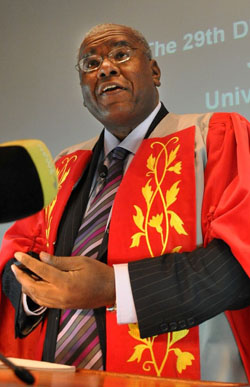 |
| Prof. Jonathan Jansen |
|
The University of the Free State (UFS) will continue to use a two-language model while it builds capacity for research and teaching in Sotho languages.
This was announced by the Rector and Vice-Chancellor of the UFS, Prof. Jonathan Jansen, when he delivered the 29th DF Malherbe Memorial Lecture on the Main Campus in Bloemfontein yesterday, on the topic: The politics and prospects of Afrikaans, and Afrikaans schools and universities.
“In the course of time black students will learn Afrikaans, white students will learn Sesotho, and all students will learn decent English,” he said.
“Classes will remain in English and Afrikaans, especially in the first years of study. Dual-medium classrooms will break down the racial isolation where outstanding university teachers are comfortable in both languages. Parallel-medium classes will exist where large numbers enable such a facility.”
He said schools and higher education institutions that continue to use language as an instrument of exclusion, rather than inclusion, would remain “culturally and linguistically impoverished”. He said the future of Afrikaans in these institutions lay in its inter-dependence and co-existence with other languages.
“A strong two-language model of education, whether in the form of double- or parallel-medium instruction within a racially integrated campus environment is the only way in which Afrikaans can and should flourish in a democratic South Africa,” he said.
“It is the only model that resolves two problems at the same time: the demand for racial equity, on the one hand, and the demand for language recognition, on the other hand.”
He said the idea of an exclusively Afrikaans university was a “dangerous” one.
“It will lock up white students in a largely uni-racial and uni-lingual environment, given that the participation rates in higher education for Afrikaans-speaking black students are and for a long time will remain very low,” he said.
“This will be a disaster for many Afrikaans-speaking students for it will mean that the closed circles of social, cultural and linguistic socialization will remain uninterrupted from family to school to university.
“Rather than prepare students for a global world marked by language flexibility and cultural diversity, students will remain locked into a sheltered racial environment at the very stage where most South African students first experience the liberation of the intellect and the broadening of opportunities for engaging with the world around them.
“The choice at the Afrikaans universities, therefore, must never be a choice between Afrikaans and English; it must be both.”
Media Release
Issued by: Lacea Loader
Director: Strategic Communication (actg)
Tel: 051 401 2584
Cell: 083 645 2454
E-mail: loaderl@ufs.ac.za
13 August 2010